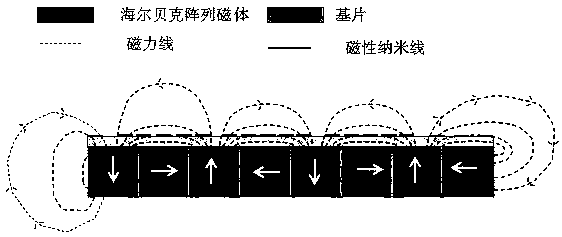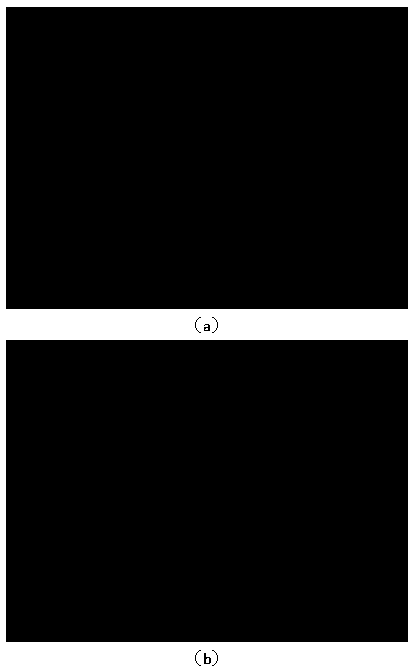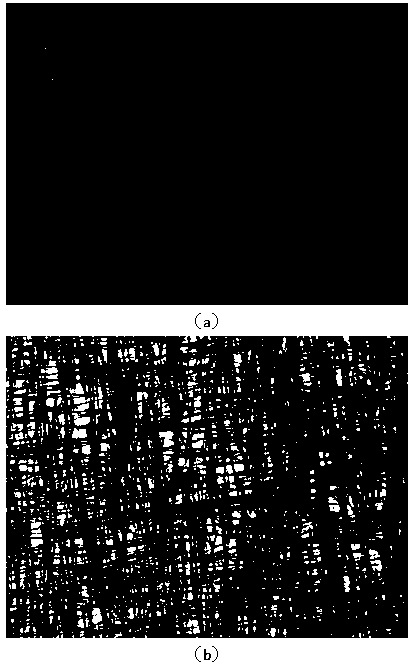Rapid deposition method for periodic ordered magnetic nanowire array
A magnetic nanometer and deposition method technology, which is applied in the field of optoelectronic devices or information engineering, can solve the problems of long array cycle and unrecyclable solvent, and achieve fast deposition speed, controllable line density and environmental friendliness
- Summary
- Abstract
- Description
- Claims
- Application Information
AI Technical Summary
Problems solved by technology
Method used
Image
Examples
Embodiment 1
[0021] Dissolve 1.2g of sodium hydroxide in 35ml of ethylene glycol, and stir for 2 hours to obtain a uniform solution; add 10ml of hydrazine hydrate solution (80% in mass content) to the above solution, stir and mix evenly, and place in a 0.2T NdFeB permanent magnet above, heated in a 60°C water bath. 5ml of 0.1M nickel chloride ethylene glycol solution was added dropwise with a syringe, and taken out after 10 minutes of reaction, and gray nickel nanowires floating above the solution were obtained. The nanowires were separated from the solution and washed three times with isopropanol to obtain a dispersion of nickel nanowires dispersed in isopropanol, which was used to prepare nickel nanowire arrays deposited on the surface.
Embodiment 2
[0023] The nickel nanowires in Example 1 were dispersed in a certain amount of isopropanol to prepare dispersions of nickel nanowires with different contents, and mixed with an oscillator for 2 minutes to obtain uniformly dispersed nickel nanowire dispersions. Put the PET substrate close to the Halbach magnet (magnetic pole spacing 0.5mm, suction force 65g / cm 2 ), a liquid tank with a certain area is fixed on the surface of the PET substrate. Pour the nickel nanowire dispersion into the liquid tank, let it stand still for 1 min, use a needle to extract the solvent and recover it, and use the natural air-dry method to volatilize a small amount of solvent on the surface of the substrate. After drying, the substrate is separated from the Halbach magnet and the liquid tank to obtain a substrate with a single-oriented periodic magnetic nanowire array on the surface.
[0024] Magnetic nanoarray substrates with different surface coverages are prepared by adjusting the nickel content...
Embodiment 3
[0029] The substrate with a nickel nanowire coverage of 10% on the surface in Example 2 was dried at 80° C. for 24 hours. Rotate the PET substrate with a single orientation on the surface by 90 degrees, and re-attach it to the surface of the Haier shell magnet. Repeat the steps of deposition, solvent recovery and drying in Example 2 to obtain an ordered network of nickel nanowires with a vertical orientation on the surface. Lattice sheet.
PUM
 Login to View More
Login to View More Abstract
Description
Claims
Application Information
 Login to View More
Login to View More - R&D
- Intellectual Property
- Life Sciences
- Materials
- Tech Scout
- Unparalleled Data Quality
- Higher Quality Content
- 60% Fewer Hallucinations
Browse by: Latest US Patents, China's latest patents, Technical Efficacy Thesaurus, Application Domain, Technology Topic, Popular Technical Reports.
© 2025 PatSnap. All rights reserved.Legal|Privacy policy|Modern Slavery Act Transparency Statement|Sitemap|About US| Contact US: help@patsnap.com



